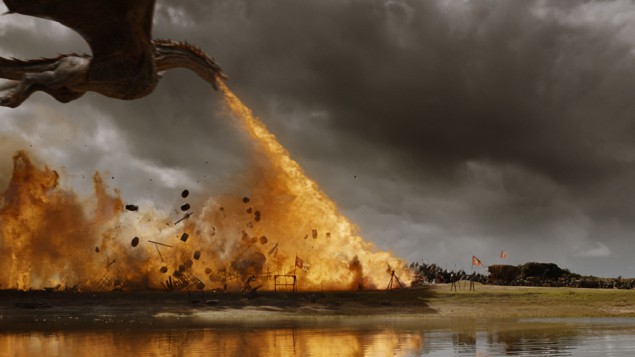Kate Gardner reviews Fire, Ice and Physics: the Science of Game of Thrones by Rebecca C Thompson

On 19 May this year, 13.6 million people around the world watched the last ever episode of Game of Thrones, the TV show based on George R R Martin’s A Song of Ice and Fire fantasy books, as it aired on HBO. That number rose to 19.3 million within 24 hours – a statistic that includes me and almost everyone I know. In the age of streaming and box sets, such large live audiences are rare outside of sports broadcasts, and the figure demonstrates both the show’s popularity and its writers’ penchant for huge plot developments that demanded immediate discussion with friends and family.
Online, fans discussed every detail of Game of Thrones, from the many war crimes committed by each character (you can refer to an excellent series of blogs by the Australian Red Cross about this), to the medieval history it roughly depicts, to whether the show was extremely sexist or extremely feminist. What physicist Rebecca C Thompson – head of the Office of Education and Public Outreach at Fermilab – particularly enjoyed were debates about the science depicted in the show. In her new book Fire, Ice and Physics: the Science of Game of Thrones, she analyses these fan theories through looking at actual physics.
But just how much physics could there be in a book series and TV show set in a fantasy universe with magic, witches, dragons and zombies? Half the battle of making a book like this work is choosing the right questions to address, and Thompson has chosen well. As physicist and science writer Sean Carroll says rather eloquently in his foreword, applying the scientific method to a fictional problem is great fun, as well as educational.
Even non-fans will have heard the series’ oft-repeated phrase “Winter is coming”, referring to the fact that the land where it is set has seasons of unpredictable duration. Thompson investigates what could possibly cause this (amazingly there is a reasonable explanation). She lays out her assumptions from the start – that Martin’s “Known World” is a planet with roughly the same physical properties as Earth, with the continent of Westeros being roughly akin to North America – and adds all the clues she can find from the books. I’ve never been so keen to truly understand precession and nonlinear dynamics – and it doesn’t hurt that Thompson has a dry sense of humour that leavens the thoroughly explained science.
Thompson moves on to the biophysics of hypothermia (whether popular character Jon Snow could have survived the season seven episode “Beyond the wall”); the materials science of an ice wall and various types of steel; zombie (or “white walker”) biology; the genetics of the Targaryen and Lannister family trees; and even the magical weapon “Wildfire”. It was fun to read about body-heat loss in physics terms – conduction, convection, evaporation and radiation – and who wouldn’t love to learn that hypothermia makes you urinate more (your metabolism increases to generate heat, which creates more waste products)? But my favourite sections of the book were about the dragons.
Of course, dragons don’t exist, but could they? Figuring out whether an animal the size of the Game of Thrones dragons could actually fly takes you from the physics of jumbo jets to dinosaur palaeontology to the biology of various non-extinct flying animals. Then there’s whether an animal could, in theory, breathe fire, which requires a physics definition of fire and its properties before getting into the biological possibilities. And as fans will know, the next question is whether an animal could produce fire hot enough to melt stone.
Fire, Ice and Physics does contain spoilers, not just of the early seasons/books but right up to the final episodes of the TV show. The book is definitely aimed at fans – those who have finished watching the final season – but the topics have broad enough interest that anyone could have a good time reading this. Thompson is herself a fan and doesn’t use this book to point out flaws or plot holes. In addition to her enthusiasm and her physics knowledge she has another card to play: she is an experienced endurance athlete. This gives her an interesting perspective when it comes to, say, survival in the extreme cold of “beyond the Wall”.
When Martin eventually finishes writing the last books in his series, I will be interested to see not only how they differ from the TV show, but also whether they resolve any of the mysteries that Thompson tackles. If there’s a better explanation for the ice wall’s existence than it being held up by sawdust and magic, then Thompson will have to publish an updated edition.
- 2019 MIT Press 274pp £20hb



